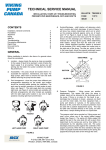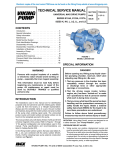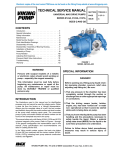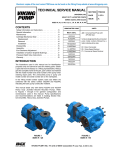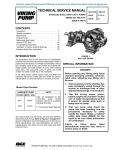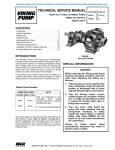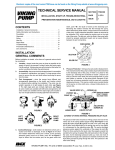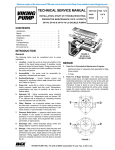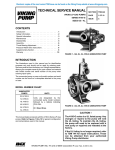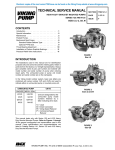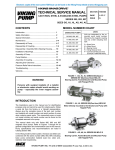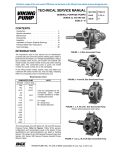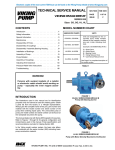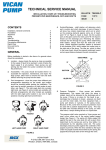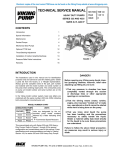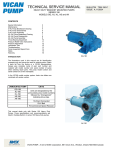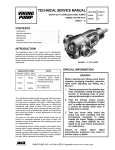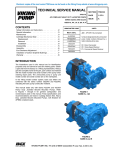Download CONTENTS INTRODUCTION TECHNICAL SERVICE MANUAL
Transcript
Electronic copies of the most current TSM issue can be found on the Viking Pump website at www.vikingpump.com TECHNICAL SERVICE MANUAL SECTION TSM 343.3 PAGE 1 of 20 ISSUE F INSTALLATION, START UP, TROUBLESHOOTING, Preventive MAINTENANCE, DO’S & DON’TS Vi-corr® Composite Pumps SERIES RP-07 & RP-407 CONTENTS Introduction 1 Special Information 2 Installation & Start Up 3 General Pump Disassembly 6 RP-07 Series (Lip Seal) 9 Disassembly & Assemby RP-407 Series (Mechanical Seal) 11 Disassembly & Assembly Troubleshooting 15 Do’s and Don’ts 17 FIgure 1 Series RP-07 Pump INTRODUCTION The illustrations used in this manual are for identification purposes only and cannot be used for ordering parts. Obtain a parts list from the factory or a Viking® representative. Always give the complete name of part, the part number and material along with the model number and serial number of the pump when ordering repair parts. The pump model and serial number can be found on the nameplate secured to the pump. In the Viking model number system, model size numbers are combined with series numbers with a suffix indicating mounted pump unit. This manual deals only with Series RP composite pumps. Refer to Figures 1 through 9 for general configuration and nomenclature used in this manual. Pump specifications and recommendations are listed in Catalog Section 343. UNMOUNTED PUMP LIP SEAL MECH. SEAL RP-0782 RP-40782 RP-0716 RP-40716 RP-0724 RP-40724 RP-0732 RP-40732 UNITS Units are designated by the unmounted pump model numbers followed by a letter indicating drive style. D = Direct Drive M = Motor Mounted (Close Coupled C-Flange) R = Viking Reducer Drive P = Commercial Reducer Drive M4 = Motor Mounted (Close Coupled Four-Bolt) VIKING PUMP, INC. • A Unit of IDEX Corporation • Cedar Falls, IA 50613 USA SPECIAL INFORMATION Rotation: Although shaft rotation determines which port is suction and which is discharge, Viking composite pumps are designed to run in a designated direction (as indicated on pump decal). The pump rotation cannot be reversed. DANGER ! Running the pump in the opposite direction to the designated direction may result in serious injury or death. DANGER ! Before opening any Viking pump liquid chamber (pumping chamber, reservoir, relief valve adjusting cap fitting etc.) Be sure: 1.That any pressure in chamber has been completely vented through suction or discharge lines or other appropriate openings or connections. 2.That the driving means (motor, turbine, engine, etc.) Has been “locked out” or made non- operational so that it cannot be started while work is being done on pump. 3.That you know what liquid the pump has been handling and the precautions necessary to safely handle the liquid. Obtain a material safety data sheet (MSDS) for the liquid to be sure these precautions are understood. Failure to follow above listed precautionary measures may result in serious injury or death. Pressure Relief Valves: 1.Relief valves are mounted on the head of all RP series composite pumps. 2.The RP series is a positive displacement pump and requires some sort of over pressure protection. Without over pressure protection, the following is likely to occur: motor stalls, drive equipment fails, a pump part breaks or the piping and/or equipment in the system bursts. This may be an integral pressure relief valve supplied with the pump, a torque limiting device or a rupture disk. 3.If a relief valve is not furnished on the pump, some means of over pressure protection, such as an in line relief valve, should be provided. 4.The relief valve adjusting screw cap must always point toward the suction side of the pump. 5.Pressure relief valves cannot be used to control flow or regulate pressure. For additional information on pressure relief valves. Refer to Technical Service Manual TSM000 and Engineering Service Bulletin ESB-31. SECTION TSM 343.3 ISSUE F PAGE 2 OF 20 INSTALLATION General The following items must be considered prior to pump installation: 1.LOCATION - locate the pump as close as possible to the supply of liquid being pumped. If possible locate the pump below liquid supply. Viking pumps are self-priming; but, the better the suction conditions, the better the pump will perform. Clockwise Rotation RP-07 & RP-407 (viewed from shaft end) Figure 2 2.ACCESSIBILITY - the pump must be accessible for inspection, maintenance and repair. 3.SUCTION/DISCHARGE - the RP series pumps are designed for clockwise rotation as standard (viewed from end of shaft). Refer to Figure 2. Mounting 1.Surfaces to which the pump mounts must be clean and flat. 2.Use SAE Grade 5 or better capscrews to mount pump. 3.The mounting capscrews for RP-07 pumps must have a minimum of ½ inch thread engagement. 4.RP series pumps with mechanical seal or lip seals are designed to be used with jaw type couplings that do not induce axial thrust on the pump shaft. If an improper type coupling is used, internal damage may result. 5.Do not strike or press the coupling half to install on the pump shaft. Damage to the pump or coupling may result. If the coupling does not slide onto pump shaft, inspect coupling bore, shaft and key for nicks or burrs and remove if present. 6.Once pump has been mounted, place a small amount of compatible liquid into suction port and turn by hand to ensure pump turns freely. Alignment Check alignment after mounting. 1.If the unit has a flexible coupling, remove any coupling guards or covers and check the alignment of the coupling halves. A straight edge (piece of key stock will work) across coupling must rest evenly on both rims at top, bottom and sides. See Figure 3. USE STRAIGHT EDGE. THESE SURFACES MUST BE PARALLEL 2.Make final check on alignment after piping is hooked up. Replace the guards. CHECK WIDTH BETWEEN THESE SURFACES WITH INSIDE CALIPERS OR FEELER GAUGE TO BE CERTAIN THE FACES ARE EQUAL DISTANCE APART AND PARALLEL. Figure 3 SECTION TSM 343.3 ISSUE F PAGE 3 OF 20 Piping/Hose The cause of many pumping problems can be traced to the suction piping. It should always be as large in diameter and as short in length as possible. Before starting the layout and installation of your piping system, consider the following points: 1. Never use piping smaller than the pump port connections. Piping larger in diameter than the port connection is sometimes required to reduce friction losses. 2. Be sure the inside of the pipe is clean before installing. 3. When approaching an obstacle to the suction line, go around instead of over it. Going over an obstacle can create an air pocket. Where practical, slope the piping so no air or liquid pockets will be formed. Air pockets in the suction line make it hard for the pump to prime. 4. A strainer on the suction side of the pump should always be considered in any pumping system. The strainer will keep foreign matter from entering the pump. The strainer mesh or perforation size should be large enough so that it does not cause excessive pressure drop, but fine enough to protect the pump. Use of a strainer is particularly important at start up to help clean the system of weld beads, pipe scale and other foreign objects. 5.A pressure relief valve is required in the discharge line. See Special Information, page 2. 6. The pump must not be used to support the piping. Hangers, supports, stands, etc. must carry the weight of the pipes. 7.When fastening piping to the pump do not impose any strain on the pump casing. “Springing” or “drawing” the piping up to the pump will cause distortion, possible misalignment and probable rapid wear of the pump. Do not use the pump to correct errors in piping layout or assembly. 8. All joints in the piping system must be tight; liquid thread sealant will help assure leak-free threaded joints. Loose joints result in liquid leaks or suction side leaks. Air leaks make the pump noisy and reduce flow. CAUTION: Be careful not to overtighten fittings as this can cause cracked joints. One full turn beyond hand tight is all that is needed for proper connection. Do not use PTFE / plumber’s tape. Reduced friction makes over tightening very easy and will result in cracked ports. 9. Drive alignment must be checked after the piping is hooked up. 10.Provide a pressure relief device in any part of a pump and piping system that can be valved off and, thus, completely isolated. A rise in temperature will cause a liquid to expand. If there is no provision for pressure relief in the closed off section, there is a chance that the pump or piping will rupture. SECTION TSM 343.3 ISSUE F PAGE 4 OF 20 Danger ! Before starting pump, be sure all drive equipment guards are in place. Failure to properly mount guards may result in serious injury or death. START UP Before pushing “start” button, check the following: 1. Are vacuum and pressure gauges (liquid filled) mounted on or near the pump? Gauges are the quickest and most accurate way of finding out what is happening in the pump. 2. Is the pump is correctly aligned with the drive equipment? 3. Make sure there is no pipe strain on the pump ports. 4. Rotate the pump shaft by hand to be sure it turns freely. 5. Before connecting to the motor, jog it to be sure it is running in the correct direction. Refer to “General” on page 3. 6. Is the pressure relief valve installed properly? 7. Make sure the suction piping is properly connected and sealed, and valves are open. 8. Make sure the discharge piping is properly connected and sealed, valves are open, and there is a place for the liquid to go. 9. Make sure all guards are in place. 10. The above checklist is a general guideline to be used prior to starting the pump. Since Viking Pump cannot foresee every application for our product and possible system design, the final responsibility is with the user. The pump must be utilized within the catalog specifications and the pump system must be designed to provide safe working conditions. The “start” button may now be pushed. The pump should begin to deliver liquid within 15 seconds! If not, push the stop button. Do not run the pump without liquid flow longer than 30 seconds or the pump may be ruined. Review Startup steps 1 through 10. Consider what the suction and discharge gauges may indicate. If everything appears in order, re-prime pump. Refer to Mounting page 3, item 6. Push the “start” button. If nothing is flowing within 30 seconds, stop the pump. The pump is not a compressor, it will not build up much air pressure. It may be necessary to vent discharge line until liquid begins to flow. Use safe venting procedures especially when handling hazardous liquids If pump still does not deliver, consider one or more of the following: 1. The suction line has air leaks. 2. The end of the suction pipe is not submerged deeply enough in the liquid. 3. The suction lift is too great or the suction piping is too small. 4. Liquid is vaporizing in the suction line before it gets to the pump. SECTION TSM 343.3 ISSUE F PAGE 5 OF 20 If after consideration of these points, the pump still does not deliver liquid, review all points given under START UP and read through the TROUBLESHOOTING guide and try again. If pump still will not deliver liquid, contact your Viking Pump supplier. SUGGESTED REPAIR TOOLS: The following are required to properly repair an RP Series pump. The tools are in addition to standard mechanics tools such as open end wrenches, pliers, screw drivers, etc. Most of the items can be obtained from an industrial supply house. 1.Soft face hammer 2.Allen wrenches 3.External snap ring pliers. Viking P/N 2-810-029-375 4. Internal snap ring pliers. Viking P/N 2-810-047-999 5.Arbor press 6.Torque wrench DANGER! Before opening any Viking pump liquid chamber (pumping chamber, reservoir, relief valve adjusting cap fitting etc.) Be sure: 1.That any pressure in chamber has been completely vented through suction or discharge lines or other appropriate openings or connections. 2.That the driving means (motor, turbine, engine, etc.) Has been “locked out” or made non- operational so that it cannot be started while work is being done on pump. 3.That you know what liquid the pump has been handling and the precautions necessary to safely handle the liquid. Obtain a material safety data sheet (MSDS) for the liquid to be sure these precautions are understood. Failure to follow above listed precautionary measures may result in serious injury or death. GENERAL PUMP DISASSEMBLY Before attempting to repair the pump, make sure that all of the details covered in “TROUBLESHOOTING” on page 15 have been checked out because disassembly of a good pump should be avoided. Due to pump construction and close tolerances used in pump manufacture, repair is seldom economically feasible, unless it is an O-ring or such, Often when some internal part wears such as a bushing, shaft or gear, it will cause excessive wear in other mating parts. In this case more components will be required to rebuild the pump back to original condition than originally expected. Replacement parts are only available as displayed in the table of parts. Contact your local distributor to obtain replacement parts. Be sure to supply the pump model number and serial number. Mark all sections of the pump during disassembly to ensure they will be reassembled in the proper order and orientation. Note: Pump must be separated from coupling to disassemble. SECTION TSM 343.3 ISSUE F PAGE 6 OF 20 ALIGN PINS GEARS SEPARATION PLATE SEPARATION WITH PORTS PLATE LIPSEAL HEAD SNAP RINGS RELIEF VALVE CAP CASING BUSHINGS O-RING BRACKET BALL BEARING DRIVER SHAFT Figure 4 Series RP- 07 Cut-Away View Figure 5 Typical RP-0782, RP-0716,40782, RP40716 Exploded View ITEM DESCRIPTION ITEM DESCRIPTION 1 External Retaining Ring 14 Separation Plate & Bushings 2 Internal Retaining Ring 15 Casing & Gears 3 Ball Bearing 16 Alignment Sleeves 4 External Lip Seal 17 Head & Bushings 5 Bracket 18 Capscrews 6a Lip Seal (RP-07) 19 Poppet, Relief Valve 6b &6c Mechanical Seal (RP-407) 20 Spring, Relief Valve 7 O-Ring 21 Adjusting Screw, Relief Valve 8 Key 22 Gasket, Relief Valve 9 Driver Shaft 23 Lock Nut, Relief Valve 10 Driven Shaft 24 Cap, Relief Valve 11 Drive Pins 25 O-Ring, Flange to Pump 12 Retaining Pins 26 Flanges 13 Separation Plate 27 O-Ring, Flange to Pipe SECTION TSM 343.3 ISSUE F PAGE 7 OF 20 Figure 6 Typical RP-0724, RP-0732,40724, and RP40732 Exploded View ITEM DESCRIPTION ITEM DESCRIPTION 1 External Retaining Ring 15, 17 Casing & Gears 2 Internal Retaining Ring 18 Alignment Sleeves 3 Ball Bearing 19 Head & Bushings 4 External Lip Seal 20 Capscrews 5 Bracket 21 Poppet, Relief Valve 6a Lip Seal (RP-07) 22 Spring, Relief Valve 6b &6c Mechanical Seal (RP-407) 23 Adjusting Screw, Relief Valve 7 O-Ring 24 Gasket, Relief Valve 8 Key 25 Lock Nut, Relief Valve 9 Driver Shaft 26 Cap, Relief Valve 10,11 Driven Shaft 27 O-Ring, Flange to Pump 12 Drive Pins 28 Flanges 13 Retaining Pins 29 O-Ring, Flange to Pipe 14,16 Separation Plate & Bushings SECTION TSM 343.3 ISSUE F PAGE 8 OF 20 DANGER! Before opening any Viking pump liquid chamber (pumping chamber, reservoir, relief valve adjusting cap fitting etc.) Be sure: 1.That any pressure in chamber has been completely vented through suction or discharge lines or other appropriate openings or connections. 2.That the driving means (motor, turbine, engine, etc.) Has been “locked out” or made non- operational so that it cannot be started while work is being done on pump. 3.That you know what liquid the pump has been handling and the precautions necessary to safely handle the liquid. Obtain a material safety data sheet (MSDS) for the liquid to be sure these precautions are understood. Failure to follow above listed precautionary measures may result in serious injury or death. RP- 07 SERIES (LIP SEAL) Disassembly: 1.Remove key from the driver shaft. 2.Remove the 4 assembly capscrews. Remove snap ring on the drive shaft in front of the bracket ball bearing. Pump is now held together by the alignment sleeves. 3.Hold the head of the pump and gently tap on the sides of the pump bracket with a soft hammer, alternating sides of the pump. This should slowly FIGURE 7 separate the sections. Note the RP-0724 SECTIONAL VIEW position of alignment sleeves for assembly. Do not hit the sections hard or use a screwdriver to pry them apart as this may damage the mating surfaces. NOTE: If pump has 2 casing and gear sets (RP-0724) and (RP-0732),the casing and gears are matched sets. Keep individual casing and gears together. See Figure 7. 4.After the pump is apart, inspect all parts for signs of wear. Look carefully at the shaft, bushings, inside of the casing, gear teeth, lip seals, and the faces of the pump sections that are located on each side of the casing for signs of wear. 5.If replacing the shafts, remove the retaining rings from both sides of the gear. Press the gear off the shaft and remove drive pin(s) or balls from the shaft. 6.Check the bracket ball bearing for roughness. Roughness can be determined by turning the inner race by hand. Replace if the bearing has roughness. SECTION TSM 343.3 ISSUE F PAGE 9 OF 20 7.If replacing the bracket bearing or product lip seal, remove the outer snap ring holding the bearing in place, and remove bearing and inner bearing snap ring. Gently tap out the lip seal with a punch and hammer, alternating sides of the lip seal. 8.Visually inspect the pump O-rings. If the O-rings are PTFE (appear to be white), it strongly recommended to replace rather than reuse. 9.If the pump has a relief valve, remove the acorn nut covering the relief valve adjusting screw. Measure the distance of the relief valve adjusting screw to the pump surface and record this length. Finish disassembling the relief valve and inspect the seat in the casing and the poppet for signs of wear or foreign matter on either surface. Assembly • The pump is ready to be reassembled after all parts have been changed and worn parts replaced. • Use a suitable lubricant compatible with the fluid being handled when reassembling the pump. • Make sure all holes machined in the bracket are clean and that the mating surfaces of each section are free of any dents or burrs. 1.If installing new lip seals, press the product side (inboard) lip seal into the bracket. See Figure 8. Press the lip seal protecting the ball bearing (outboard) into the bracket with lip facing inward. 2. Pack silicone or other grease against the outboard lip seal. Install the inner internal snap ring, ball bearing, and outer internal snap ring. Slide the shaft into bracket ball bearing and install the snap ring. bearing lip seal ball bearing internal snap rings 3.Place the bracket, mounting face Figure 8 down, on blocks to allow stable assembly of pump. Place O-ring into the O-ring groove. Install the alignment sleeves into the proper holes by tapping with a soft faced hammer. 4.Slide the separation plate onto the alignment sleeves with O-ring groove up and the side notch positioned on the inlet side of the pump. Place O-ring into the O-ring groove. RP-0724 and RP-0732 only. Lubricate the bushings in the separation plate with oil or compatible liquid. Place the drive pin or pins in the groove on the driver shaft and slide the gear onto the shaft over the pins. Install the driven shaft and gears into remaining the bushing bore. The driven gear should be attached to the shaft with drive pin or pins and snap rings. Slide the casing onto the alignment pins with O-ring groove up and lubricate gears. Place O-ring in the O-ring groove. NOTE: Gears and casing are matched sets and must be assembled in pump together. SECTION TSM 343.3 ISSUE F PAGE 10 OF 20 5.Slide the separation plate with ports onto the alignment sleeves with O-ring groove up. The pump will require more than one pair of alignment sleeves; install alignment sleeves as necessary. Lubricate bushings in the separation plate with ports with oil or compatible liquid. Install O-ring into the O-ring groove. 6.Place drive pin or pins into the groove on the driver shaft and slide the gear onto the shaft over pins. Install driven shaft and gears into the remaining bushing bore. The driven gear should be attached to the shaft with drive pin or pins and snap rings. Slide the casing onto the alignment pins with O-ring groove up and lubricate the gears. Place O-ring in the O-ring groove. 7.Lubricate bushings in the head. Slide head onto the alignment sleeves with the relief valve on inlet side of the pump. If the pump is not equipped with a relief valve, assemble the head with side flat on the inlet side. 8.Install the 4 capscrews and tighten the torque wrench to 25 ft-lbs. 9.Reassemble the relief valve, setting the adjusting screw to previous dimension. Place gasket onto adjusting screw while tightening the locknut. Recheck dimension, install second gasket on other side of the locknut and install the acorn nut. 10.Install drive key into the drive shaft keyseat. DANGER! Before opening any Viking pump liquid chamber (pumping chamber, reservoir, relief valve adjusting cap fitting etc.) Be sure: 1.That any pressure in chamber has been completely vented through suction or discharge lines or other appropriate openings or connections. 2.That the driving means (motor, turbine, engine, etc.) Has been “locked out” or made non- operational so that it cannot be started while work is being done on pump. 3.That you know what liquid the pump has been handling and the precautions necessary to safely handle the liquid. Obtain a material safety data sheet (MSDS) for the liquid to be sure these precautions are understood. Failure to follow above listed precautionary measures may result in serious injury or death. RP- 407 SERIES (MECHANICAL SEAL) Disassembly: 1. Remove key from driver shaft. 2.Remove the 4 assembly capscrews. Remove the snap ring on the drive shaft in front of the bracket ball bearing. The pump is now held together by the alignment sleeves. SECTION TSM 343.3 ISSUE F PAGE 11 OF 20 3.Hold the head of the pump and gently tap on the sides of the pump bracket with a soft faced hammer, alternating sides of the pump. This should slowly separate the sections. Note the position of alignment sleeves for assembly. Do not hit the sections hard or use a screwdriver to pry them apart as this may damage the mating surfaces. NOTE: If pump has 2 casing and gear sets (RP-40724) and (RP-40732), the casing and gears are matched sets. Keep the individual casing and gears together. Reference Figure 7. 4.After the pump is apart, inspect all parts for signs of wear. Look carefully at the shaft, bushings, inside of casing, gear teeth, lip seals, and the faces of the pump sections that are located on each side of the casing for signs of wear. 5.If replacing the shafts, remove the retaining rings from both sides of the gear. Press the gear off the shaft and remove the drive pin(s) or balls from the shaft. 6.Check the bracket ball bearing for roughness. Roughness can be determined by turning the inner race by hand. Replace if the bearing has roughness. 7.If replacing the bracket bearing or product lip seal, remove the outer snap ring holding the bearing in place, and remove the bearing and inner bearing snap ring. Gently tap out the lip seal with a punch and hammer, alternating sides of lip seal. 8.If replacing the mechanical seal, remove the stationary seal seat from the bracket and slide the rotating member of the seal off the drive shaft. 9.Visually inspect the pump O-rings. If the O-rings are PTFE (appear to be white), it strongly recommended to replace rather than reuse. 9.If pump has a relief valve, remove the acorn nut covering the relief valve adjusting screw. Measure the distance of the relief valve adjusting screw to the pump surface and record this length. Finish disassembling the relief valve and inspect the seat in the casing and the poppet for signs of wear or foreign matter on either surface. Assembly • The pump is ready to be reassembled after all parts have been changed and worn parts replaced. • Use a suitable lubricant compatible with the fluid being handled when reassembling the pump. • Make sure all holes machined in the bracket are clean and that the mating surfaces of each section are free of any dents or burrs. 1.If installing new lip seals, press the product side (inboard) of lip seal into the bracket. See BEARING Figure 9. Press the lip seal protecting the ball LIP SEAL bearing (outboard) into the bracket with lip BALL facing inward. BEARING 2.Pack silicone or other grease against outboard lip seal. Install the inner internal snap ring, ball bearing, and outer internal snap ring. Slide the shaft into the bracket ball bearing and install the snap ring. 3.Place the bracket, mounting face down, on blocks to allow stable assembly of the pump. Place O-ring into the O-ring groove. Install alignment sleeves into the proper holes by tapping with a soft faced hammer. SECTION TSM 343.3 ISSUE F PAGE 12 OF 20 INTERNAL SNAP RINGS Figure 9 4.If installing new mechanical seal, check the driver shaft keyway and the bracket seal bore for burrs and remove any that are found. The sealing faces on mechanical seals should not be touched with anything but clean fingers or a clean cloth. Rubber Bellows Type Mechanical Seals (refer to Figure 10) BRACKET Install retaining ring into the retaining ring groove on the shaft. Apply a liberal coating of lubricant to the shaft. Start the rotary member; seal face out, onto shaft and push along shaft until the rotary member contacts seal retaining ring. ROTARY MEMBER RETAINING RING DRIVER SHAFT Lubricate outside diameter of the stationary seat O-ring. Press the stationary seal seat into the bracket bore, lapped face out. STATIONARY SEAT figure 10 PTFE Fitted Type Mechanical Seal (Refer to figure 11) Install retaining ring into the retaining ring groove on shaft. Apply a liberal coating of lubricant to the shaft. Slide the rotary member onto the shaft and push along until it contacts the retaining ring. Make sure the rotating seal face points towards you when installing. Tighten all set screws securely to the shaft. BRACKET ROTARY MEMBER SEAL DRIVE PIN DRIVER SHAFT RETAINING RING STATIONARY SEAT NOTE: Some PTFE seals are figure 11 equipped with holding clips which must be removed after seal is installed on the shaft to release the seal springs. Lubricate the outside diameter of the stationary seat PTFE wedge. Press the stationary seal seat into the bracket bore aligning the notch in back of the seal seat with the drive pin in the bottom of the seal bore in the bracket. 5.Flush the sealing faces of both rotary members and seal seat with lubricant. 6.Slide the shaft into the bracket ball bearing and install the snap ring. Place O-ring into the O-ring groove. Install the alignment sleeves in the proper holes by tapping with a soft faced hammer. SECTION TSM 343.3 ISSUE F PAGE 13 OF 20 7.Slide the separation plate onto the alignment sleeves with the O-ring groove up and the side notch positioned on the inlet side of pump. Place O-ring into O-ring groove. RP-0724 and RP-0732 only. Lubricate bushings in the separation plate with oil or a compatible liquid. Place drive pin or pins in the groove on driver shaft and slide the gear onto the shaft over the pins. Install driven shafts and gears into the remaining bushing bore. The driven gear should be attached to the shaft with drive pin or pins and snap rings. Slide the casing onto alignment pins with the O-ring groove up and lubricate the gears. Place O-ring in the O-ring groove. NOTE: The gears and casing are matched sets and must be assembled in the pump together. 8.Slide the separation plate with ports onto the alignment sleeves with the O-ring groove up. The pump will require more than one pair of alignment sleeves as necessary. Lubricate bushings in separation plates with ports with oil or compatible liquid. Install O-ring into the O-ring groove. 9.Place drive pin or pins into the groove on the driver shaft and slide the gear onto the shaft over the pins. Install the driven shaft and gears into the remaining bushing bore. The driven gear should be attached to the shaft with the drive pin or pins and snap rings. Slide the casing onto the alignment pins with the O-ring groove up and lubricate the gears. Place Oring in the O-ring groove. 10.Lubricate the bushings in head. Slide head onto the alignment sleeves with relief valve on inlet side of the pump. If the pump is not equipped with a relief valve, assemble the head with side flat on inlet side. 11. Install the 4 capscrews and tighten with a torque wrench to 25 ft-lbs. 12.Reassemble the relief valve, setting the adjusting screw to previous dimension. Place the gasket onto the adjusting screw while tightening the locknut. Recheck dimension, install second gasket on other side of locknut and install acorn nut. 13. Install the drive key into the drive shaft keyseat. SECTION TSM 343.3 ISSUE F PAGE 14 OF 20 TROUBLESHOOTING A Viking pump that is properly installed and maintained will give long satisfactory performance. If trouble does develop, one of the first steps toward finding the difficulty is to install a vacuum gauge in the suction line and a pressure gauge in the discharge line. Readings on these gauges often give a clue on where to start looking for trouble. DANGER ! Before opening any Viking pump liquid chamber (pumping chamber, reservoir, relief valve adjusting cap fitting etc.) be sure: 1.That any pressure in chamber has been completely vented through the suction or discharge lines or other appropriate openings or connections. 2.That the driving means (motor, turbine, engine, etc.) has been “locked out” or made non-operational so that it cannot be started while work is being done on the pump. 3.That you know what liquid the pump has been handling and the precautions necessary to safely handle the liquid. Obtain a material safety data sheet (MSDS) for the liquid to be sure these precautions are understood. Failure to follow the above listed precautionary measures may result in serious injury or death. Vacuum Gauge - Suction Port High vacuum reading would indicate: 1. The suction line is blocked, valve closed, a strainer is plugged or a pinched suction line. 2. The suction line is too small. 3. The liquid is too viscous to flow through the piping. 4. The lift required is too high. Low reading would indicate: 1. There may be an air leak in the suction line. 2. The end of the pipe is not in the liquid. 3. The pump is worn. 4. The pump is dry and should be primed. SECTION TSM 343.3 ISSUE F PAGE 15 OF 20 Fluttery, jumping or erratic reading would indicate: 1. The liquid is vaporizing. 2. Liquid is coming in to the pump in slugs, possibly an air leak or insufficient liquid above the end of the suction pipe. 3.Vibration from cavitation, misalignment, or damaged parts. Pressure Gauge - Discharge Port High reading would indicate: 1. High viscosity and small diameter and/or lengthy discharge line. 2.The strainer or filter is plugged. 3.The pressure relief valve is set too high. 4.Valve in the discharge line partially closed. 5. Line may be partially plugged from build up on the inside of the pump, solidified product or foreign object. 6.Liquid in the pipe is not up to temperature. Low reading would indicate: 1. Pressure relief valve may be set too low. 2.Pressure relief valve poppet is not seating properly. 3.The bypass around the pump is partially open. 4.Pump is damaged or worn. 5. The pump has too much internal clearance. Fluttery, jumping or erratic reading would indicate: 1.Cavitation. 2.Liquid is coming to the pump in slugs. 3.Air leak in the suction line. 4.Vibrating from misalignment or mechanical problems. Miscellaneous Some of the following may also help pinpoint the problem. Pump does not pump: 1. The pump has lost its prime from air leak or low level in tank. 2.The suction lift is too high. 3.Rotating in the wrong direction. 4.The motor does not come up to speed. 5.The strainer is clogged. 6.The bypass valve is open, pressure relief valve set too low, or pressure relief valve poppet stuck open. 7.The pump is worn out. 8.Any changes in liquid, system or operation that would help explain the trouble, e.g. new liquid, additional lines or process changes. SECTION TSM 343.3 ISSUE F PAGE 16 OF 20 Pump starts, then loses its prime: 1.The supply tank is empty. 2.The liquid is vaporizing in the suction line. 3.There is an air leak or air pockets in the suction line. 4.The pump is worn out. Pump is noisy: 1. The pump is cavitating (liquid vaporizing in suction line) or being starved (heavy liquid cannot get to pump fast enough). Increase the suction pipe size and/or reduce the length, or decrease the pump speed. If the pump is above the liquid, raise the liquid level closer to the center line of the inlet port. If the liquid is above the pump, increase the head of the liquid. 2.Check alignment. 3.Anchor the base or piping to eliminate vibration. Pump not delivering up to capacity: 1.The pump is starving or cavitating – see Pump is noisy, item 1. 2.The strainer partially clogged. 3.Air leak somewhere in the suction line. 4.Running too slow. Is the motor the correct speed and wired up correctly? 5.Pressure relief valve is set too low, stuck open or has damaged poppet seat. 6.The bypass line around the pump partially opened. 7.The pump is worn out. Pump takes too much power (stalls motor): 1.Liquid is more viscous than the is unit sized to handle. 2.The system pressure relief valve set too high. 3.The pump is misaligned. DO’S AND DON’TS Do’s and Don’ts for installation, operation and maintenance of Viking pumps to promote safe, long, trouble free operation. Installation: 1.DO install the pump as close to supply tank as possible. 2.DO leave working space around the pumping unit. 3.DO use large diameter pipe with short and straight runs. 4.DO install a strainer in the suction line. 5.DO a double check of alignment after unit is mounted and piping is hooked up. 6.DO provide pressure relief valve for discharge side of pump. 7.DO check for proper rotation. 9. DO use piping, hose and fittings rated for maximum system pressure. 10. DO check to make sure all guards are in place. SECTION TSM 343.3 ISSUE F PAGE 17 OF 20 Operation 1. DON’T run the pump at speeds faster than those shown in the catalog for your pump. 2.DON’T allow the pump to develop pressure higher than those shown in catalog for your pump. 3.DON’T operate pumps at temperatures above or below limits shown in catalog for your pump. 4.DON’T operate unit without all guards in place. 5.DON’T operate pump without a pressure relief valve in discharge piping; be sure the valve is mounted and set correctly. 6.DON’T operate the pump with all the liquid bypassing through the internal pressure relief valve or with out any flow of liquid going through the pump for more than 30 seconds. Operation under either of these conditions may result in heat build up and damage to the pump. 7.DON’T work on the pump unless driver has been “locked out” so it cannot be started while work is being done on the pump. Maintenance: 1.DO record pump model number and serial number and file for further use. 2.DO have spare parts, pump or stand by units available, particularly if pump is essential part of key operation process. 3.DO obtain, read and keep all maintenance instructions furnished with pump. 4.DO make sure any pump that has residual system pressure in it or that has handled high vapor pressure liquids, has been vented through the suction or discharge lines or other openings provided for this purpose. 5. DO make sure that if the pump is still hooked to the driver while maintenance is being performed that the driver has been “locked out” so that it cannot be inadvertently started while work is being done on the pump. 6.DO make sure any pump that has handled a corrosive, flammable, hot or toxic liquid has been drained, flushed, vented and/or cooled before it is disassembled. SECTION TSM 343.3 ISSUE F PAGE 18 OF 20 SECTION TSM 343.3 ISSUE F PAGE 19 OF 20 WARRANTY Viking warrants all products manufactured by it to be free from defects in workmanship or material for a period of one (1) year from date of startup, provided that in no event shall this warranty extend more than eighteen (18) months from the date of shipment from Viking. The warranty period for Universal Seal series pumps ONLY (Universal Seal models listed below) is three (3) years from date of startup, provided that in no event shall this warranty extend more than forty-two (42) months from the date of shipment from Viking. UNDER NO CIRCUMSTANCES SHALL VIKING BE LIABLE UNDER THIS WARRANTY OR OTHERWISE FOR SPECIAL, INCIDENTAL, INDIRECT, CONSEQUENTIAL OR PUNITIVE DAMAGES OF ANY KIND, INCLUDING, BUT NOT LIMITED TO, LOST OR UNREALIZED SALES, REVENUES, PROFITS, INCOME, COST SAVINGS OR BUSINESS, LOST OR UNREALIZED CONTRACTS, LOSS OF GOODWILL, DAMAGE TO REPUTATION, LOSS OF PROPERTY, LOSS OF INFORMATION OR DATA, LOSS OF PRODUCTION, DOWNTIME, OR INCREASED COSTS, IN CONNECTION WITH ANY PRODUCT, EVEN IF VIKING HAS BEEN ADVISED OR PLACED ON NOTICE OF THE POSSIBILITY OF SUCH DAMAGES AND NOTWITHSTANDING THE FAILURE OF ANY ESSENTIAL PURPOSE OF ANY PRODUCT. THIS WARRANTY IS AND SHALL BE VIKING’S SOLE AND EXCLUSIVE WARRANTY AND SHALL BE IN LIEU OF ALL OTHER WARRANTIES, EXPRESS OR IMPLIED, INCLUDING, BUT NOT LIMITED TO, ALL WARRANTIES OF MERCHANTABILITY, FITNESS FOR A PARTICULAR PURPOSE AND NON-INFRINGEMENT ALL OF WHICH OTHER WARRANTIES ARE EXPRESSLY EXCLUDED. See complete warranty at www.vikingpump.com. © 3/2013 Viking Pump Inc. All rights reserved VIKING PUMP, INC. • A Unit of IDEX Corporation • Cedar Falls, IA 50613 USA




















